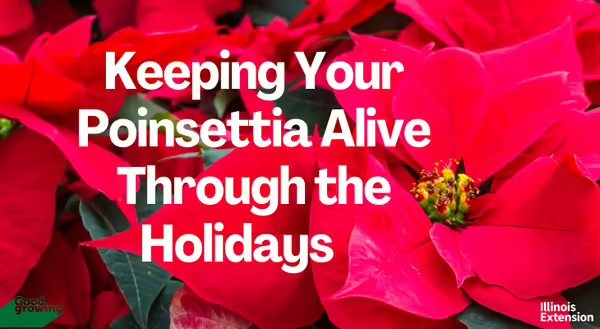
Poinsettias are one of the most popular holiday plants with their bright color providing festive Christmas décor, but if you have ever been gifted a poinsettia or been tempted to purchase one due to their showy, colorful bracts (leaves), you know they aren’t the easiest plant to keep alive much past the holidays.
Being native to Mexico, poinsettia plants grow naturally as a shrub and change color in response to shorter winter days (short day plants). The ones we purchase at the store have been grown in a greenhouse where the light exposure has been manipulated to trigger flowering in time for the holiday season. What we consider to be flowers are bracts that look like petals with tiny yellow flowers in the center called cyathia. Traditionally, we think of poinsettias as a bright red, but today, you can find them to fit almost any color scheme; ranging from white, pink, red, and even some with patterns of these colors. You may have also noticed blue or purple poinsettias; these are cream colored varieties that have been spray painted.
If you do decide to purchase a poinsettia, be sure to properly wrap the plant for its trip from the store to its destination. These are tropical plants, and low temperature exposure even for a few minutes can cause damage to the bracts and leaves. Once the plant is home, put it in a spot where it will receive bright, indirect light for at least six to eight hours per day; they also prefer a room temperature between 65 to 75 degrees Fahrenheit. Avoid placing plants in an area with fluctuating temperatures such as near cold drafts, heat ducts, fireplaces, etc.
Keep the soil moist by watering when the soil surface feels dry to the touch. It is a good idea to remove the decorative foil or punch holes in it to allow for excess water to drain. Fertilization is not necessary when poinsettias are blooming; once plants begin growing again, you can feed them with an all-purpose plant fertilizer every 3 to 4 weeks to support new growth. As the plant grows, you should consider transplanting your poinsettia into a larger container with good drainage (about 2 to 4 inches larger than the original pot); this is typically done in late spring or early summer.
If you are successful at keeping your poinsettia alive until next fall, congratulations! To get your poinsettia to “flower” or change color, the plant needs complete darkness from 5 PM to 8 AM beginning at the end of September until the bracts start to change color in about early to mid-December. This can be done by putting the plant in the closet, a dark room (be sure no one accidentally turns the light on), or in a box. To keep the plant in good shape, continue to water and move the plant to sunlight during the day. And if your poinsettia doesn’t survive or change color, there will always be new poinsettias available next year.
MEET THE AUTHOR
Katie Parker is a Local Foods and Small Farms Educator with University of Illinois Extension, serving Adams, Brown, Hancock, Pike, and Schuyler counties. Katie provides programming with an emphasis on row crop production, soil fertility, composting, vegetable production, and ornamental horticulture.
Signup for our emails! Want to get notified when new Good Growing posts are available? SIGN ME UP